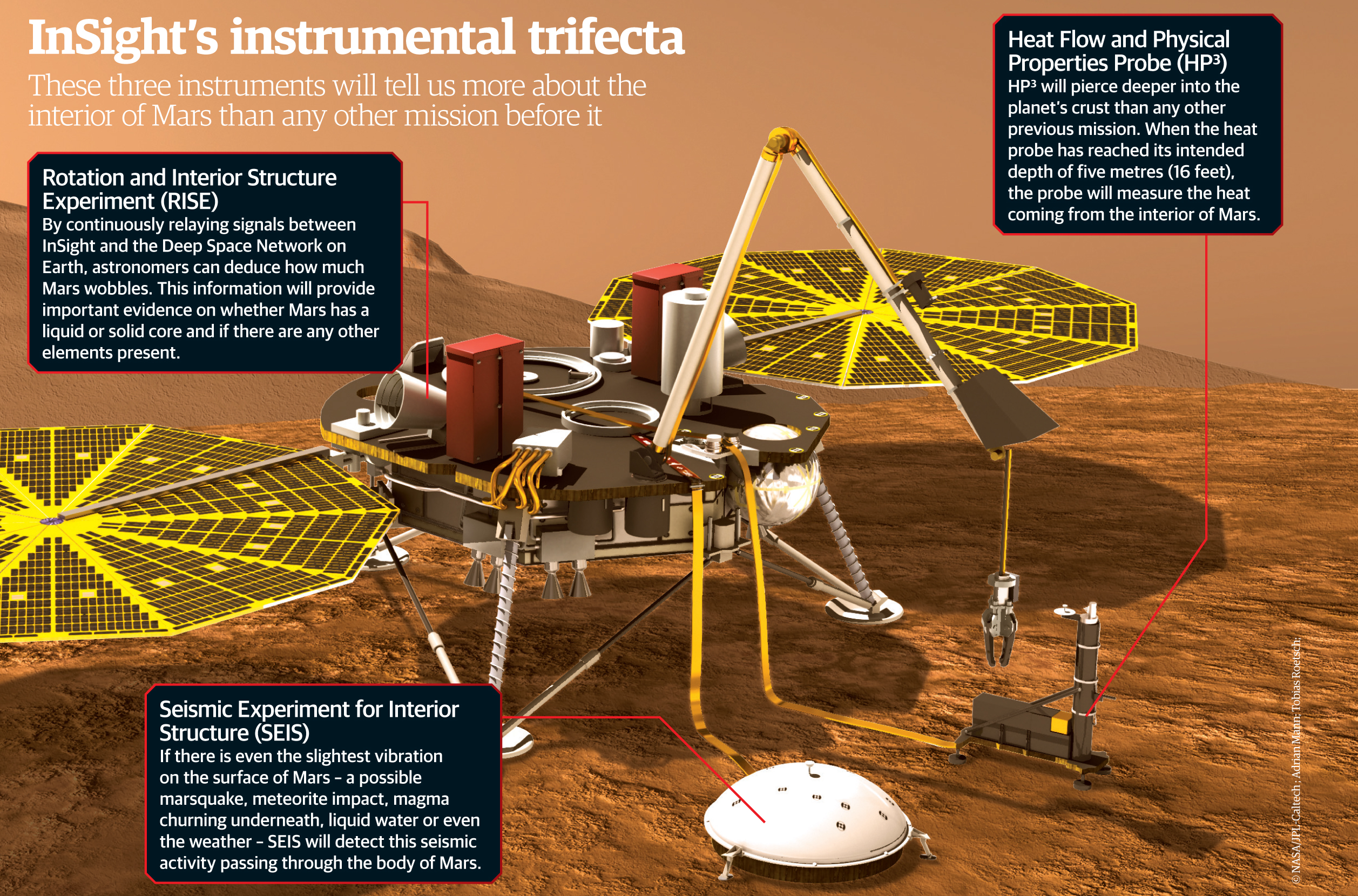PASADENA, Calif. — They don't call it "7 minutes of terror" for nothing.
NASA's InSight Mars lander is scheduled to touch down on the Red Planet tomorrow afternoon (Nov. 26), and mission team members and agency officials are understandably nervous about the make-or-break moment.
Less than half of all Mars missions, be they orbiters or landers, have aced their Red Planet arrivals over the decades, Thomas Zurbuchen, Associate Administrator of NASA's Science Mission Directorate in Washington, D.C., noted during a news conference here today (Nov. 25) at the agency's Jet Propulsion Laboratory (JPL). [NASA's InSight Mars Lander: Full Coverage]
"So, we're of course worried," Zurbuchen said. "We recognize that you never take Mars for granted. Mars is hard."

The difficulty for landed missions stems chiefly from the fact that Mars features both a relatively strong gravitational pull and a wispy atmosphere, which is just 1 percent as thick as that of Earth, said Tom Hoffman, InSight project manager at JPL. So, approaching spacecraft get accelerated to high speeds and then have a hard time dissipating enough energy to slow down before landing, he explained during today's news conference.
InSight will hit the Martian atmosphere a little before 3 p.m. EST (2000 GMT) while traveling about 12,300 mph (19,800 km/h). The spacecraft must nail its target entry angle of 12 degrees precisely, team members have said: Any steeper, and InSight will burn up; any shallower, and the vehicle will bounce off the atmosphere and careen into space.
Atmospheric drag will eventually slow InSight down to about 840 mph (1,350 km/h), and then the craft will deploy its supersonic parachute, Hoffman said. Shortly before touchdown, InSight will fire up its retrorockets, allowing it to settle onto the red dirt at just 5 mph (8 km/h). You can keep tabs on all the action live here on Space.com, courtesy of NASA.
Breaking space news, the latest updates on rocket launches, skywatching events and more!
This is the same entry, descent and landing (EDL) strategy employed by NASA's Phoenix lander, which touched down safely in the Martian arctic in May 2008. There is no rocket-powered sky crane, which lowered the agency's heavier Curiosity rover onto the Red Planet's surface in August 2012. (InSight's EDL sequence will take about 6.5 minutes, instead of the 7 minutes experienced by Curiosity. But some NASA officials and InSight team members have rounded up, referring to the upcoming trial by fire as "7 minutes of terror" as well.)
Both Hoffman and Zurbuchen expressed confidence that InSight will succeed tomorrow, as did mission principal investigator Bruce Banerdt, also of JPL. All three stressed that the mission team has done all it can to anticipate and mitigate potential problems.
"But you just never know what's going to happen," Hoffman said. "Everything has to go perfectly, and Mars could always throw us a curveball."
Hoffman also copped to a case of nerves, and he predicted that all of the pent-up excitement and worry will come bursting out tomorrow upon getting the first "I'm OK" signals from InSight on the Martian surface.
"I'm totally going to unleash my inner four-year-old," Hoffman said.
After the touchdown, InSight — whose name is short for "Interior Exploration using Seismic Investigations, Geodesy and Heat Transport" — can get to work. The stationary lander will be the first spacecraft ever to probe Mars' interior, gathering data about the Red Planet's structure and composition. Such information will shed light on how rocky worlds such as Mars and Earth form and evolve, mission officials have said.

InSight will do this using a suite of super-sensitive seismometers and a heat probe, which will hammer itself up to 16 feet (5 meters) beneath the Martian surface. Mission team members will also use the lander's communications gear to measure the slight wobble of Mars' axis of rotation, which in turn should reveal key details about the planet's core.
The $850 million InSight mission launched on May 5, along with two tiny cubesats called MarCO-A and MarCO-B. The briefcase-size tag-alongs are technology demonstrators designed to show that cubesats can indeed explore interplanetary space; the MarCO duo will also aim to beam home data from InSight during the EDL sequence tomorrow, though this task isn't crucial to the lander's success. (MarCO-A and MarCO-B won't join InSight on the suface; they'll fly past Mars.)
InSight's launch came about two years later than planned. The probe missed its original March 2016 launch window after a leak was detected in the vacuum chamber surrounding the seismometer suite. Mars and Earth align properly for interplanetary missions just once every 26 months, so the InSight team had to wait a while even after fixing the leak.
Visit Space.com Monday, Nov. 26, for complete coverage of the InSight landing on Mars.
Mike Wall's book about the search for alien life, "Out There" (Grand Central Publishing, 2018; illustrated by Karl Tate) is out now. Follow him on Twitter @michaeldwall. Follow us @Spacedotcom or Facebook. Originally published on Space.com.
Join our Space Forums to keep talking space on the latest missions, night sky and more! And if you have a news tip, correction or comment, let us know at: community@space.com.

Michael Wall is a Senior Space Writer with Space.com and joined the team in 2010. He primarily covers exoplanets, spaceflight and military space, but has been known to dabble in the space art beat. His book about the search for alien life, "Out There," was published on Nov. 13, 2018. Before becoming a science writer, Michael worked as a herpetologist and wildlife biologist. He has a Ph.D. in evolutionary biology from the University of Sydney, Australia, a bachelor's degree from the University of Arizona, and a graduate certificate in science writing from the University of California, Santa Cruz. To find out what his latest project is, you can follow Michael on Twitter.
